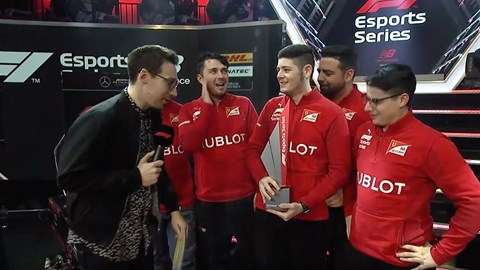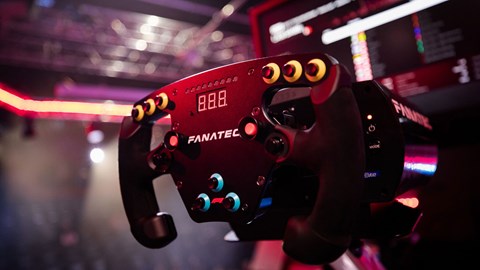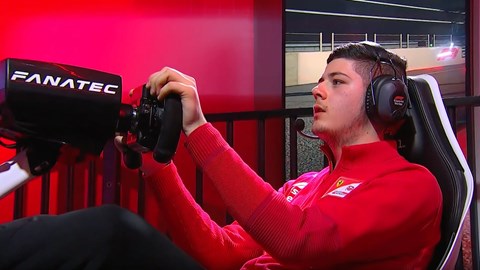► Behind F1’s search for a wider, younger audience
► All about the second FIA-approved esports racing series
► Reporting from the season finale
A Ferrari driver has won an F1 championship for the first time since Kimi Raikkonen’s triumph of 2007. But instead of beating a self-destructing McLaren team on track, Maranello’s latest champion, David Tonizza, has just held back the best from Red Bull and Mercedes on a video game. Instead of Interlagos, we’re in the equally noisy, South West London-based Gfinity arena, and we’ve just witnessed ‘Tonzilla’ come from behind to win the third-ever F1 esports championship.
Ever since Liberty Media bought F1 in mid-2017, it’s been on a mission to open up and refresh the pinnacle of motorsport. From a more engaging Twitter account that posts race footage ad-hoc, to an in-house YouTube show, Formula One is on a digital charm offensive as it looks to generate a younger, larger fanbase. As a T-rex dressed in Ferrari red continues to dance on stage, it’s hard not to agree that this is a shot in the arm F1 has needed.

Liberty Media’s plan mainly involves social media platforms, but – like GT Sport – F1 has jumped on the esports train. At the finale of the FIA-approved 2019 F1 esports world championship, we spoke to Julian Tan, head of digital business and esports at F1 about connecting the sport to a new, growing audience – and why gaming will play a key role.
Some context
Lewis Hamilton may be the current king of the F1 paddock, but his sphere of influence is shrinking. Whether it’s because of the previous stingy online strategy, a perceived lack of competition or TV licensing deals, F1’s audience is on a downward trajectory; its fanbase is ageing and it’s not growing either.
While sports such as Formula E seem to have been designed from the beginning with fan engagement in mind (and perhaps a little too much in the case of FanBoost), F1 has had to enter an entirely new area to find new fans.
‘In order to open up the sport and reach out to a new audience, you have to take a little bit of a radical approach – and I would consider jumping into the world of esports a pretty radical thing,’ explains Tan.

‘Esports was identified as one of the key pillars of our digital transformation,’ he adds, and that’s partly because of the young audience it draws in. ‘Having studied the industry and knowing its growth potential, we felt very compelled to be able to jump in headfirst, really, and sort of navigate the space and learn as we as we went along.’
Why esports?
In 2019, racing esports made the leap from emerging series to something more established. Over in the second-ever GT Sport championship Mikal Hizal succeeded Igor Fraga as the Nations Cup champion, while in F1 esports, David Tonizza became the second champion ever, after Brandon Leigh’s two wins on the bounce. This year every F1 team was represented in the FIA-approved esports series, and that’s partly because it makes so much sense to brands from a marketing point of view.
F1 sees massive potential in the young, and primarily Asian, audience of esports, in the same way brands such as Renault do: it’s marketing gold dust. ‘We have to find new ways in which we can actually speak to a new generation of fans, a generation of fans that are digitally active. It’s a global fan base,’ Tan explains.
‘We needed to go into [esports], we needed to create a product that spoke to this new generation of fans in a way that they understand so that we can build that pipeline of the fanbase for the real-world Formula One, and secure its future in that sense.’
Compatibility: connecting the virtual to the real
So, F1 had the means – but is esports really on brand? Does the fully licensed, rights-heavy, official world F1 actually fit into the esports way of life? Tan thinks so, and suggests it actually lends itself to esports in some ways.
‘The racing that we’re able to create in the sports is hugely engaging,’ he says. ‘All of the cars are equalised, which makes for a close race. So closer racing, and the drivers themselves are more risk taking. So that creates a level of racing that you’re not always able to replicate in real life.’

And on top of more aggressive – but clean – racing, viewers tuning into F1 esports will be able to pick things up straight way. ‘You don’t really need to have a deep understanding of the game to jump in and, and appreciate the f1 esports content,’ Tan adds. ‘Because racing is very easy to understand and whoever crosses the line first wins. Whereas if you draw comparisons to other esports, like League of Legends or Fortnite, if you don’t play the game, you won’t necessarily be able to follow the esports series.’
What next for F1 esports?
Sceptical? You shouldn’t be. According to Tan, the F1 esports championship is already generating huge clicks online on Twitch, YouTube and Twitter, and it’s being pushed out by the main F1 account for some added authority, too. It seems esports is being used as a feeder series for the F1 audience of tomorrow, in the same way it’s being used as a talent search for the real drivers of the future.
While Ford sets up its own esports team and the GT Sport championship goes from strength to strength, the F1 esports series is determined not to be left behind – but equally to remain true to the sport it simulated.

‘We have a North Star, and it’s ensuring we can align the world of the power of esports with the magic of Formula One, combining those two things to create something that’s unique,’ Tan promises.
‘It’s difficult to say what [esports] will look like necessarily because the landscape is constantly evolving. And in many ways, it’s our imperative to adapt with those changes so that we can ensure that Formula One discourse continues to be relevant in a way that is additive and supportive of our main product – which is what we put out on the track.’